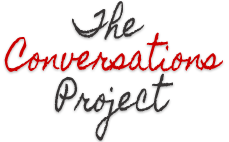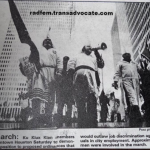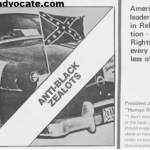Welcome to our guide to the jargon that peppers conversations about the intersection of the trans and radical feminist experience. We’ve tried to focus on terms and concepts common to discourse found in our Community Group and present them clearly while also preserving some of the nuance of history and discursive context. If you notice that we’ve missed a term that should be included in this glossary, please feel free to let us know!
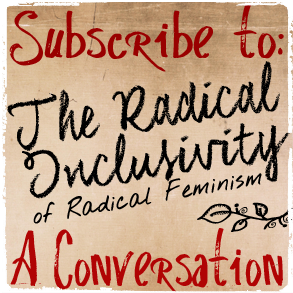
1st Wave: Feminism from the mid-1800s to the early 1900s, which tended to focus on women’s suffrage. Racism was a significant issue and genderqueer individuals were shut out of the movement.
2nd Wave: Feminism from around 1945 – 1980. This wave of feminism was focused on Women’s Liberation. To the dismay of intersectional 2nd Wave feminists, privilege-blind optics became a problem within 2nd wave feminist discourse. At this time, Janice Raymond’s Transsexual Empire: The Making of the She-Male gained some measure of favor.
3rd Wave: Feminism from around 1980 – 2010. Focused on addressing exclusionary practices of previous feminist waves. Sandy Stone, a trans woman and victim of Janice Raymond’s harassment, published The Empire Strikes Back and was well received. In the name of liberation, some within 3rd wave feminism participated in promoting “raunch culture“, giving rise to the so-called “Female Chauvinist Pig.”
4th Wave: (AKA Intersectional Feminism) Feminism from around 2010 – current. Focused on inclusivity (explicitly trans inclusive) and embraces significant (especially online) discourse. Websites like Autostraddle (4th wave lesbian culture) and Feministing (4th wave youth culture) exemplify 4th wave discourse.1 Unfortunately, sex essentialist activists have begun using “4th Wave Feminism” as a euphemism for their brand of anti-trans feminism.
Bathroom Meme: A meme that is historically used against oppressed classes which argues that should an oppressed group gain equality, immoral or unethical behavior will ensue inside bathrooms. This meme was used against the end of racial segregation within the American South, successfully used against the passage of the Equel Rights Amendment (ERA), against the civil rights of people with HIV2, against gay people, against the end of DADT3 and is used against trans people.

Figure 1: Vic Lockman, The Equal Rights Amendment, a Trojan Horse, Alton, Illinois: Eagle Forum, 1976, p. 8
Cisgender (Cis): Short for cisgender. Cis is Latin for “
Cisnormative: The standard of normalcy in a culture that tends to privilege cis cultural archetypes over all others.
Cisprivilege: Refers to a set of unearned advantages that individuals who identify as the gender they were assigned at birth accrue solely due to having a cisgender identity.
Cotton Ceiling: A discourse among trans people concerning itself with the way physical cisnormative beauty standards impact notions of desirability, how these biases relate to the fetishization of trans people, how it impacts the perception of trans people in queer spaces and how these cisnormative standards affect the body image of trans people. In other words, it is a conversation about the way cisnormative beauty standards affect the way trans people see themselves as well as the way in which it biases the way others view trans people. The “cotton” in the name of the term refers to the clothing covering the (fetishized, reviled, etc) bodies of trans people. Sex essentialist anti-trans activists often assert that the Cotton Ceiling is actually a conspiracy on the part of trans people and/or Planned Parenthood to rape lesbians.
FAAB: Female Assigned At Birth
Female: One whose genotype, phenotype, and/or legal persona is regarded by society as being typical of the political class “woman”.
Feminism: The advocacy of women’s rights on the grounds of political, social, and economic equality to men. 5
Gender: is a generic term we use to refer to any/all aspects of: gender orientation, expression and identity (see image below); gender role, stereotype and hierarchy; and/or, any mental contextualization of the material reality of genotyped and phenotyped sex.
Gender Critical Feminism: A label sex essentialists use to distance themselves from the “TERF” label. Gender Critical Feminists (GCF) generally present a sex essentialist ideology outside of an asserted “radical feminist” perspective.
Gender Binary: The view of patriarchy that there are only two genders, “man” and “woman,” with gender stereotypes seen as inherent or “natural.” People who identify as some other or nonbinary gender category, or who are gender nonconformist or gender variant by defying the stereotypes, are said to “break the binary.”
Gender Expression: The complex and nuanced ways humans communicate gender identity and orientation. This includes written, oral/body language, fashion, etc.
Gender Identity: When most trans people speak of gender identity, they mean gender orientation (see below). Gender identity can also mean the contextual labels we use when we socially construct sexed personas. Therefore, “gender identity” within trans discourse may refer to gender orientation, one’s sexed persona or both.
Gender Hierarchy: In sexism, gender hierarchies are the product of gender roles. Part of the male gender role is to accept, protect and promote one’s status as an oppressor class while part of the female gender role is to accept, protect and promote one’s status as an oppressed class.
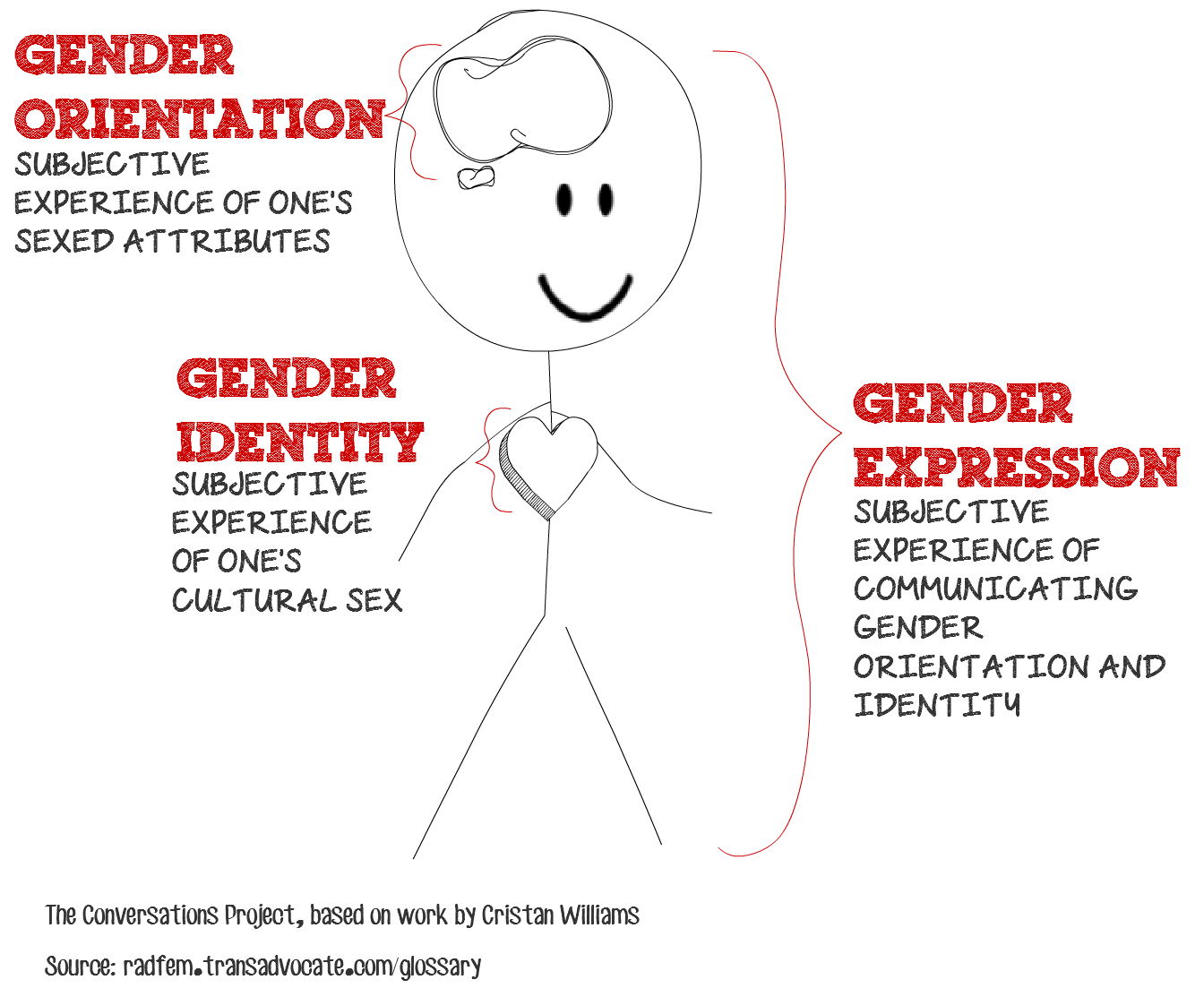
Figure 2: model of gender orientation, identity and expression
Gender Orientation: One’s subjective experience of one’s body, including it’s sexed attributes. In other words, everyone who possesses consciousness will have a private and subjective experience of having a human body. Part of that private and subjective experience will include that body’s primary and secondary sexed attributes. One’s experience of that reality is gender orientation.
Gender Role: In sexism, gender roles function to promote a culturally perceived sex-segregated society. Being placed into a role is something that culture forcibly does to people and in this way nobody may choose to live in a gender role. Should society deem that one is a male, that person will be placed into a male role by culture; should society deem that one is female, that person will be placed into a female role by culture.
Gender Stereotype: In sexism, sex segregated culturally constructed norms and taboos are propagated throughout society by culture and are applied to those who are perceived by culture to be either male or female. These norms and taboos produce a culturally prescriptive form which helps culture identify people within its binary system.
Genderqueer: (noun) the political position of rejecting gender roles, stereotypes, hierarchies and existing outside the male/female binary; or, (adjective) referring to a person who, having rejected gender roles, stereotypes, hierarchies and existing outside the male/female binary, self-identifies their gender identity as being genderqueer. As a gender identity, genderqueer is distinct from either “man” or “woman” and also known as a “nonbinary” identity. Genderqueer people may identify as both binary genders, or some distinct third category, or as “genderfluid” (alternating between two or more categories), or as having no gender at all (“agender” or “neutrois”). The rise of the genderqueer concept in the early and middle 1990s was linked to the advent of queer theory.
Genotype: The genetic constitution of an individual organism. Often contrasted with phenotype.6
Hate: the feeling intense or passionate dislike for someone or something.

Figure 3: Intersectional quote on the MLK memorial in Washington, DC
Intersectionality: The awareness that different types of oppression intersects and cannot be artificially disentangled from the experience of oppression. In other words, one might be differently abled, a rape survivor, economically disadvantaged and an intersex woman of color (WOC). To assert that her problem in life is merely the patriarchy is to willfully turn a blind eye to the complexity of the systematic oppression she faces.
Intersex: Someone whose genotype is not typical of male/female body binary sex designations. One’s intersex genotype might – but will not always – affect one’s phenotype.
Lateral Violence: Displaced aggression; the tendency of oppressed people to oppress others within their constituent grouping.
Klan Fallacy: since the Ku Klux Klan was the one group that enjoyed the most success at politicizing and weaponizing the Oppressed-As-Rapist meme, activists refer to this meme as the Klan Fallacy. In the 1915 Klan movie The Birth of a Nation, a “Black” man (played by a white man) was stereotyped as a rapist. The Oppressed-As-Rapist meme was subsequently used to make all Black men look like potential rapists which meant (in white supremacist culture) that, their racial segregation wasn’t irrational. This Fallacy is used against trans people when people and organizations cite (oftentimes debunked cases) of purported criminality by one trans person to then argue that therefore, all trans people may be likewise criminally inclined.
Kyriarchy: A system of domination built though intersecting forms of oppression. It is “a theory about the nature of structural power developed in feminist biblical hermeneutics by Elisabeth Schüssler Fiorenza (1992), and describes multiple, interacting structures of power and domination.” 7
MAAB: Male Assigned At Birth.
Male: one whose genotype, phenotype, and/or legal persona is regarded by society as being typical of the political class “man”.
Man: A political class that is pressured by culture to subjugate women.
MRA: Men’s Rights Activist.
Patriarchy: A social system, sustained by sexism, that privileges men and subjugates women.
Phenotype: The set of observable characteristics of an individual resulting from the interaction of its genotype with the environment.8
POMO: Postmodern. Some sex essentialist activists deride those who distinguish between the perception, attitudes, regard, awareness and languaging of sex and the material reality of body attributes as being “POMO”.
Radical: Within social justice movements, “radical” means that the movement seeks to get at the root of oppression.
RadFem: (#RadFem) A social media term used to identify internet trolls who usually claim a “radical feminist” identity, but have little understanding of radical feminist theory. Generally, so-called RadFems compensate for this lack of theoretical understanding with sometimes obsessive ad hominem attacks and appeals to biologism and sex essentialism in the name of a “radical feminism”. While this term is contemporarily used in this way on social media platforms such as Twitter, “RadFem” was traditionally used as a shortened form of “radical feminist” and therefore referred to one whose goal was the end of sexism.
Radical Feminism (RadFem): closely tied to 2nd wave feminism, it represents the identity many (though certainly not all) sex essentialist activists utilize when engaging in anti-trans activism. Radical Feminism itself exists to do away with sexism through the abolition of gender roles, stereotypes and hierarchies.9
I assure them them I am as a real and as radical a feminist as one can be […] “Feminism is a movement to end sexism, sexist exploitation, and oppression.”10
Save Our Children (SOC): The political argument that supporting the discrimination of a minority group equates to saving children from harm.
- Klan sign reads, Save Our Children
- Anti-trans political call-to-action from Florida
- In 1956 racists claimed that racial equality would endanger children
SET: Sex Essentialist Theory. An umbrella term that can be inclusive of all types of (oftentimes intersecting forms of) sex essentialist ideologies.
Sex: A social identifier assigned to babies at birth. It is taken to connote the genotypical aspects/attributes of human development as it relates to the ability to produce size-differentiated gametes. Additionally, sex is taken to connote the oftentimes stereotyped phenotypical aspects of sexed bodies such as primary and secondary sex characteristics.
Sexism: In simple terms, sexism refers to social systems in which Gender Stereotypes + Gender Roles = Gender Hierarchies.
Sex Binary: The view of patriarchy that there are only two sexes, male and female, and that these sexes are a natural and immutable natural reality. The sex binary erases or marginalizes both intersex people (whose physical sex at birth is not seen as fitting into either binary category) and transsexual or transgender people who transition to a different sex (binary or nonbinary) than their assigned sex at birth.
Sex Essentialism: In short, sex essentialism is a tautology that seeks to construct ontology through reductivism. It is the belief that there is a specific essence, that if found to be present, causes an entire body to be either male or female. The appealed to essence can be asserted social habits learned through socialization, spirit energy or emotion, or phenotype or genotype attribute.
Sex Essentialist Feminism: A set of beliefs, views, morals and ethics, asserted to be “feminist” in nature, built upon sex essentialist theories.
Sex Essentialist Theorists: Groups ranging from right-wing religious movements to TERFs who use sex essentialism as part of a central organizing belief, view, moral and/or ethic.
Sex Reassignment: The constellation of surgical and medical therapies intended to physically change a person from one sexual phenotype to the other. 11
Straight: Someone who, in a political, social and/or personal context, embraces heteronormativity.
TERF: Trans Exclusionary RadFem. A term used to identify those individuals who sympathize with and support a brand of “radical feminism” that is so rooted in sex essentialism and its resulting biologism, it actively campaigns against the existence, equality and/or inclusion of trans people. The term appears to have been popularized in 2008 by a cisgender feminist on a blog called FinallyFeminism101. TERFs generally claim that gender identity is the same thing as gender role.
Transition: The constellation of processes a trans person undertakes to physically, legally and socially move from one sexed identification to another.
Transgender (trans, trans*, TG): an umbrella term that may encompass a variety of people including transsexuals, cross dressers, drag kings and queens, as well as bigender and androgynous individuals. Transgender, came into common usage during the 1970s, but the earliest known use was in 1965 to refer to transsexuals who wanted genital reconstructive surgery. Today, the term is used to refer to individuals who are not cisgender and is denoted by writing trans (with no asterisk). Trans with an asterisk (trans*) connotes that one is speaking in terms of an encompassing umbrella.
Transsexual: A person whose phenotype aligns with or is in the process of aligning with males if FAAB or females if MAAB.
Transman/trans man: Geographically, the term is often written as one word in the south and central parts of the US and as two words – trans man – on the east and west coast, though the linguistic trend is towards using two words. This term refers to a person who was sexed female at birth and who, through the process of transition, has a male phenotype. Sex essentialists generally use “transman” (without a space) as a way to conceptualize trans men as being different than “real men”.
Transmisogyny: The intersection of the hate of women and the hate of trans people.
Transphobia: Generally refers to the strong tendency to reject non-cisgender people, issues, causes and/or concerns. Within trans discourse, the “phobia” in transphobia usually refers to the strong behavioral tendency to reject (eg, a “hydrophobic” substance). However, the term in very specific instances, may be utilized to indicate a presumed fear-based cause to observed anti-trans behaviors.
Transwoman/trans woman: Geographically, the term is often written as one word in the south and central parts of the US and as two words – trans woman – on the east and west coast, though the linguistic trend is towards using two words. This term refers to a person who was sexed male at birth and who, through the process of transition, has a female phenotype. Some sex essentialists use “transwoman” (without a space) as a way to conceptualize trans women as being different than “real women”.
Trigger: An event that brings on symptoms of Post Traumatic Stress.
Queer: Someone who, in a political, social and/or personal context, rejects heteronormativity.
Queer Theory: An outgrowth of feminist theory beginning around 1990 focusing on the socially constructed nature of both the sex and gender binaries; the changing concepts and categories of human sexuality in different times, places, and cultures; and the connection between feminism and sex/gender minority groups. Such groups include intersex people, transsexual and other transgender people, Lesbian/Gay/Bisexual cultures at various intersections such as race and nationality, etc. Queer theorists such as Judith Butler, Leslie Feinberg, Anne Fausto-Sterling, and Jack Halberstam raise challenging questions for radical feminist theory and practice.
WBW: Womyn-born womyn. A concept that is strongly associated with trans-exclusionary Michigan Womyn’s Music Festival culture. It posits an ad naturam claim to what is constructed to be essentially “woman” within the context of WBW culture.
Woman: A political class that is pressured by culture to be subordinate to men.
Women’s Liberation: The end of sexism.
Xenophobia: Intense or irrational dislike or fear of people from other countries.12
- Munro, Ealasaid. “Feminism: A Fourth Wave?” Political Insight, 2013, 22-25.
- “Coming from [Houston,] Texas, the city of the January 19, 1985, anti-gay rights referendum which went 4 to 1 against gay right, I live in a city of intolerance where political groups spread misinformation about AIDS — information that gay men get AIDS because they have sewer sex and deserve it and heterosexuals get AIDS because gay men rape children in the park. AIDS is spread by towels in public restrooms, by flushing toilets, and by hairdressers.” – Ostrow, David G. “Practical Issues in Guideline Development and Risk Reduction Education.” In Biobehavioral Control of AIDS, 119. New York: Irvington, 1987.
- “Most concerns we heard about showers and bathrooms were based on stereotype— that gay men and lesbians will behave as predators in these situations, or that permitting homosexual and heterosexual people of the same sex to shower together is tantamount to allowing men and women to shower together.” – United States. Department of Defense. In Report of the Comprehensive Review of the Issues Associated with a Repeal of “Don’t Ask, Don’t Tell”, 13. 2010.
- “Definition of Cisgender in English.” Cisgender. Accessed September 15, 2015.
- “Definition of Feminism in English.” Feminism. Accessed November 14, 2015.
- “Definition of Genotype in English:.” Genotype. Accessed September 15, 2015.
- Osborne, N. “Intersectionality and Kyriarchy: A Framework for Approaching Power and Social Justice in Planning and Climate Change Adaptation.” Planning Theory, 2013, 130-51.
- “Definition of Phenotype in English.” Phenotype. Accessed September 15, 2015.
- Anne Koedt. “Lesbianism and Feminism“. 1971
- bell hooks, Feminism is for Everybody, p viii
- Segen’s Medical Dictionary. S.V. “Sex reassignment therapy.” Retrieved September 15 2015.
- “Definition of Xenophobia in English.” Xenophobia. Accessed December 21, 2015.
